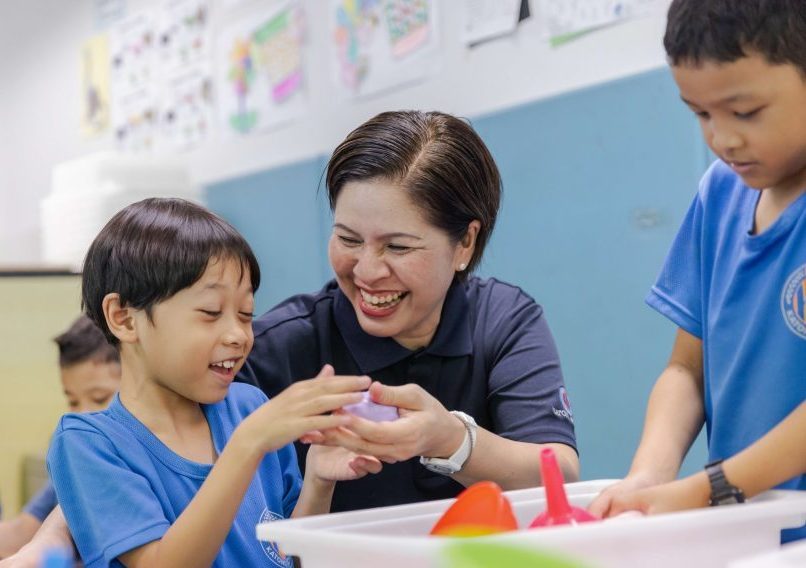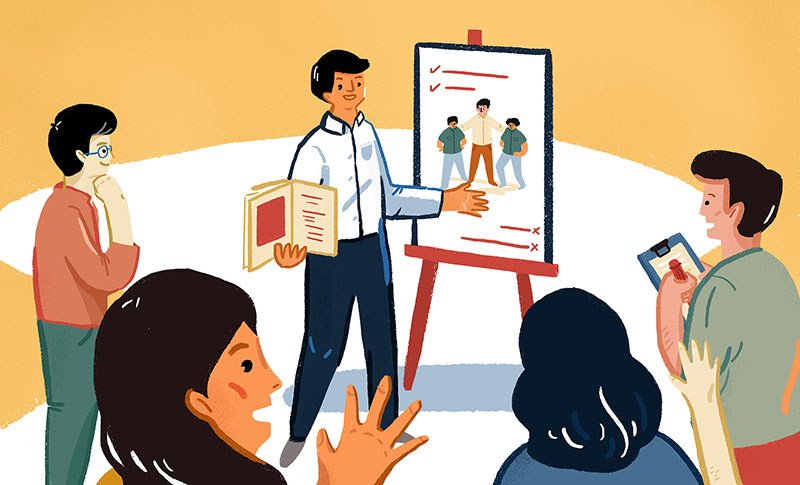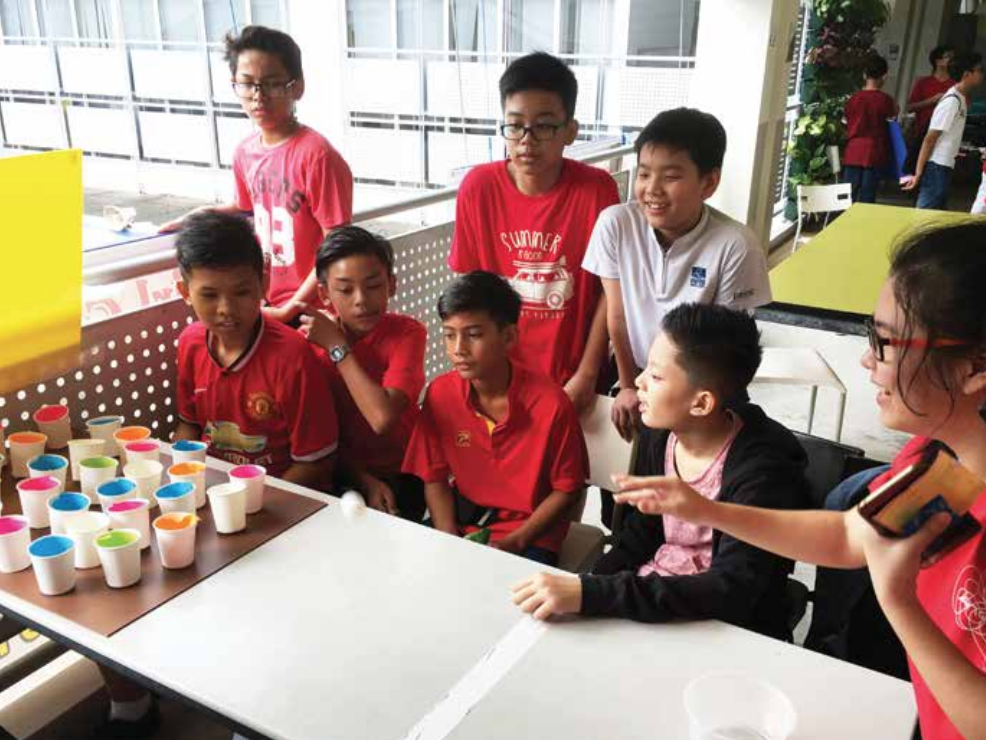At APSN Katong School, Mrs Sarah de Castro Sacro explored new frontiers. Recognising the importance of diverse interactions, the school integrated classes for its students with Mild Intellectual Disability (MID) with their peers who also have autism. Despite initial hesitation from staff and parents, Mrs Sarah and her team persevered. Their goal: to prepare students for a diverse society, while encouraging acceptance and a greater understanding of differences.
“Our students will never be completely ‘ready’ for every situation. How can we equip ourselves to better support them?”
Mrs Sarah de Castro Sacro
To support the teachers with this transition, Mrs Sarah, together with the occupational therapists and her team enhanced the school’s sensory integration programme, a programme that aims to help students manage their behavioural responses and regulate their emotions through activities that engage their senses. She equipped teachers with emotional regulation strategies to help students calm down when they are stressed or perk up when they are feeling low. This helped to minimise potential meltdowns.
Students who prefer structured routines and may have specific sensory needs, along with those who are more socially motivated but require additional cognitive support, can now learn comfortably together.
Mrs Sarah and our other two Outstanding SPED Teacher Award (OSTA) recipients stand out for their willingness to initiate change and take action. Not content with the status quo, they seek new ways to improve their teaching methods and the learning environment for their students.
To teach numeracy and social skills, she recreates a cinema experience, complete with popcorn
In APSN Katong School, Mrs Sarah incorporates sensory experiences into her lessons. In one lesson, her students write with shaving cream. Its smooth, cool texture soothes anxious students, while the repetitive motion of forming letters and numbers helps some students focus and relax. In another lesson combining touch and Maths, students dig through sand for hidden coins and count them. This activity satisfied their sensory needs while allowing them to learn numeracy.

Recognising the value of sensory activities for her students, Mrs Sarah collaborated with allied professionals, to enhance the school’s three-prong sensory integration programme for Primary 1 to 3 students. The programme, which includes sensory regulation activities, sensory play lessons, and sensory breaks, was particularly helpful for two groups of students: those seeking constant sensory input and those easily overwhelmed by sensory stimuli. Through these activities, teachers soon noticed that students were more focused and better prepared for lessons.
A strong advocate for both sensory play and experiential learning, Mrs Sarah once transformed her classroom into a ‘cinema’.
Students formed a line at the makeshift ticket booth and popcorn stand, with young ‘cashiers’ greeting their peers and taking orders. Before the movie started, students found their assigned seats. By mimicking a real cinema experience, students learnt foundational numeracy skills and cinema etiquette, such as hushed movements and keeping their voices down.
“I never imagined experiencing a cinema in a classroom during COVID times,” shares Hadirah Chynta Binte Kamarudin, now a primary 5 student. “I learnt how to calculate the cost of tickets and had fun designing the popcorn counter.”
By crafting lessons around real-life scenarios, Mrs Sarah enables her students to learn how to travel alone, ask for help when lost, and shop for food.
“Learning is not about completing worksheet after worksheet. Students learn better and gain confidence through fun real-world experiences.”
Mrs Sarah

Sports shaped her growth, and now she uses physical activities to help her students grow

As a young girl, Ms Rasyidah Binti Andi Satria often spent her Saturdays at APSN Chaoyang School, playing alongside students with special educational needs during Co-Curricular Activities led by her mother, also a special education (SPED) teacher then serving at the school.
Through playing sports like basketball, Ms Rasyidah learnt to value aspects such as teamwork more, shifting her focus beyond just winning. She also learnt to communicate effectively and appreciate the unique strengths of her peers.
Today, Ms Rasyidah is the Head of Department for Physical Education, Aesthetics and Art at APSN Chaoyang School. Starting as a teacher aide in 2001, she has spent over two decades empowering students with mild intellectual disabilities through sports and arts.
“Growing up, sports brought me joy and excitement. Only later did I realise the impact physical education can have, especially for students with special needs.”
Ms Rasyidah Binti Andi Satria
Ms Rasyidah actively seeks to maximise the potential of her students, one of them being Carol Ho Siew Fong. She helped Carol gain confidence in her sporting abilities through the school’s Talent Development Programme, which she oversees. As Carol participated more in sports, her natural abilities began to shine. She also began focusing better in class and interacting more confidently with her peers.
As a board member at Special Olympics representing APSN, Ms Rasyidah worked with staff to provide ongoing training and competition opportunities for APSN students.
Ms Rasyidah’s consistent presence at events cheering Carol on helped her stay confident and motivated. Competing in the 400m race and mini javelin events at the 2023 Special Olympics World Games in Berlin, shows just how far Carol has come.
To broaden her students’ social experiences, Ms Rasyidah and her colleagues encourage participation in Play Inclusive, a sports competition where students from mainstream schools and SPED schools form unified teams, comprising students from both schools. Together, the students dive into floorball, football, and badminton. Students forge new friendships and broaden their social circles.
For those more inclined towards visual and performing arts, Ms Rasyidah collaborates with the Disabled People’s Association and Distinct Creative Arts. One project, called the Inclusive Flashmob, saw students perform choreographed routines along Orchard Road and in heartland malls.

Ms Rasyidah also shared video recordings with parents so that the students could practise at home. Her dedication bore fruit as parents watched their children, some of whom previously assessed by parents to be unable to perform publicly, dance with conviction.

“When they’re up on stage, you can’t tell who has special needs and who doesn’t. This is what I’ve always aimed for — to provide our students with opportunities to shine and show the world what they’re capable of.”
Ms Rasyidah
Her innovative teaching approach of photo editing draws students’ interest
When Ms Tng Lee Khim first became a teacher, she did not anticipate that photo editing would become one of her most valuable teaching tools at Maitri School.
Ms Tng works with children with moderate to severe autism. Some of them struggle with abstract concepts and relate better when they ‘see themselves’ in the learning materials. Her photo-editing skills come in handy when she edits her students’ faces into cartoon images or even simple animations.
By seeing themselves in the visuals, students can better anticipate and understand their own reactions. This approach is particularly effective for teaching emotions and preparing students for new experiences. For instance, a lesson on ‘feeling nervous’ might have a photograph of a student looking anxious before a school performance.

Observing each child closely, Ms Tng experiments with various teaching tools and strategies to discover what resonates best with them.
For Gareth, a student who struggled with emotional regulation and often ran off during group activities, she introduced a reward chart and incorporated sensory and movement breaks into his routine. To help him stay alert and focused, she employed objects that he could touch and feel like squish balls, kinetic sand, and fidget toys. Collaborating with an occupational therapist, Ms Tng also introduced activities such as pulling exercises with a stretching band and flipping tyres.
Ms Tng photographed these activities and compiled them into a booklet, which she shared with her teaching assistants and Gareth’s parents. The booklet enabled them to use the same strategies at home.

By the end of the year, Gareth learnt to stay between activities and got better at handling his emotions.
“Every child is different. What works for one might not work for another, so I create a personalised plan for each student to help them learn best.”
Ms Tng Lee Khim
As a mentor, Ms Tng extends her observant approach from classroom to mentorship. She encourages fellow teachers to customise their resources and involve parents in the learning process.
“When teachers involve parents and customise materials for the children, you can see the spark in their eyes. The teachers enjoy it because they notice higher engagement and better focus from the students,” Ms Tng observes of her mentees.
Working closely with both educators and families, she has observed improvements in her students’ learning and their relationships with loved ones. “Our work with a child ripples outward,” she reflects. “Providing opportunities to all students, regardless of ability, impacts not just the child, but their entire support system.”






